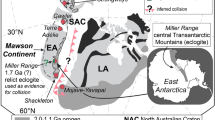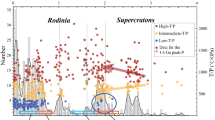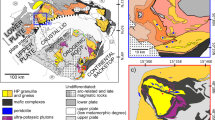Abstract
The Trans-Hudson orogen of North America is a circa 1,800 million year old, middle Palaeoproterozoic continental collisional belt. The orogen may represent an ancient analogue to the Himalayan orogen, which began forming 50 million years ago and remains active today. Both mountain belts exhibit similar length scales of deformation and timescales of magmatism and metamorphism. A notable divergence in this correlation has been the absence of high-pressure, low-temperature metamorphic rocks in the Trans-Hudson compared with the Himalaya. It has been debated whether this absence reflects a secular tectonic change, with the requisite cool thermal gradients precluded by warmer ambient mantle temperatures during the Palaeoproterozoic, or a lack of preservation. Here we identify eclogite rocks within the Trans-Hudson orogen. These rocks, which typically form at high pressures and cool temperatures during subduction, fill the gap in the comparative geologic record between the Trans-Hudson and Himalayan orogens. Through the application of phase equilibria modelling and in situ U–Pb monazite dating we show that the pressure–temperature conditions and relative timing of eclogite-facies metamorphism are comparable in both orogenies. The results imply that modern-day plate tectonic processes featuring deep continental subduction occurred at least 1,830 million years ago. This study highlights that the global metamorphic rock record (particularly in older terrains) is skewed by overprinting and erosion.
This is a preview of subscription content, access via your institution
Access options
Access Nature and 54 other Nature Portfolio journals
Get Nature+, our best-value online-access subscription
$29.99 / 30 days
cancel any time
Subscribe to this journal
Receive 12 print issues and online access
$259.00 per year
only $21.58 per issue
Buy this article
- Purchase on Springer Link
- Instant access to full article PDF
Prices may be subject to local taxes which are calculated during checkout






Similar content being viewed by others
Change history
24 December 2020
A Correction to this paper has been published: https://doi.org/10.1038/s41561-020-00685-x
References
Bédard, J. H., Harris, L. B. & Thurston, P. C. The hunting of the snArc. Precambrian Res. 229, 20–48 (2013).
Polat, A. et al. The origin and compositions of Mesoarchean oceanic crust: evidence from the 3075 Ma Ivisaartoq greenstone belt, SW Greenland. Lithos 100, 293–321 (2008).
Brown, M. Duality of thermal regimes is the distinctive characteristic of plate tectonics since the Neoarchean. Geology 34, 961–964 (2006).
Stern, R. J. Evidence from ophiolites, blueschists, and ultrahigh-pressure metamorphic terranes that the modern episode of subduction tectonics began in Neoproterozoic time. Geology 33, 557–560 (2005).
Brown, M. Metamorphic conditions in orogenic belts: a record of secular change. Int. Geol. Rev. 49, 193–234 (2007).
Hoffman, P. F. United plates of America, the birth of a craton: early Proterozoic assembly and growth of Laurentia. Annu. Rev. Earth Planet. Sci. 16, 543–603 (1988).
Lewry, J. & Stauffer, M. The Early Proterozoic Trans-Hudson Orogen of North America (Geological Association of Canada, Special Paper 37, 1990).
Corrigan, D., Pehrsson, S., Wodicka, N. & de Kemp, E. The Palaeoproterozoic Trans-Hudson orogen: a prototype of modern accretionary processes. Geol. Soc. Lond. Spec. Pub. 327, 457–479 (2009).
St-Onge, M. R., Van Gool, J. A. M., Garde, A. A. & Scott, D. J. Correlation of Archaean and Palaeoproterozoic units between northeastern Canada and western Greenland: constraining the pre-collisional upper plate accretionary history of the Trans-Hudson orogen. Geol. Soc. Lond. Spec. Pub. 318, 193–235 (2009).
Green, O., Searle, M. P., Corfield, R. I. & Corfield, R. M. Cretaceous-Tertiary carbonate platform evolution and the age of the India-Asia collision along the Ladakh Himalaya (northwest India). J. Geol. 116, 331–353 (2008).
St-Onge, M. R., Searle, M. P. & Wodicka, N. Trans-Hudson orogen of North America and Himalaya-Karakoram-Tibetan orogen of Asia: structural and thermal characteristics of the lower and upper plates. Tectonics 25, 1–22 (2006).
Eaton, D. W. & Darbyshire, F. Lithospheric architecture and tectonic evolution of the Hudson Bay region. Tectonophysics 480, 1–22 (2010).
Thompson, D. A. et al. Precambrian crustal evolution: seismic constraints from the Canadian Shield. Earth Planet. Sci. Lett. 297, 655–666 (2010).
Bastow, I. D. et al. Precambrian plate tectonics: seismic evidence from northern Hudson Bay, Canada. Geology 39, 91–94 (2011).
Corrigan, D. in Tectonic Styles in Canada: The LITHOPROBE Perspective (eds Percival, J. A., Cook, F. & Clowes, R.) Ch. 4, 237–284 (Geological Association of Canada, Special Paper 49, 2012).
Parrish, R. R., Gough, S., Searle, M. P. & Waters, D. J. Plate velocity exhumation of ultrahigh-pressure eclogites in the Pakistan Himalaya. Geology 34, 989–992 (2006).
Lanari, P. et al. Deciphering high-pressure metamorphism in collisional context using microprobe mapping methods: application to the Stak eclogitic massif (northwest Himalaya). Geology 41, 111–114 (2013).
St-Onge, M. R., Rayner, N., Palin, R. M., Searle, M. P. & Waters, D. J. Integrated pressure–temperature–time constraints for the Tso Morari dome (northwest India): implications for the burial and exhumation path of UHP units in the western Himalaya. J. Metamorph. Geol. 31, 469–504 (2013).
Brown, M. in When did Plate Tectonics Begin on Planet Earth? (eds Condie, K. C. & Pease, V.) 97–128 (Geological Society of America, Special Paper 440, 2008).
Brown, M. The contribution of metamorphic petrology to understanding lithosphere evolution and geodynamics. Geosci. Front. 5, 553–569 (2014).
St-Onge, M. R. & Ijewliw, O. J. Mineral corona formation during high-P retrogression of granulitic rocks, Ungava orogen, Canada. J. Petrol. 37, 553–582 (1996).
Lucas, S. B. Structural evolution of the Cape Smith thrust belt and the role of out-of-sequence faulting in the thickening of mountain belts. Tectonics 8, 655–676 (1989).
St-Onge, M. R. & Lucas, S. B. Large-scale fluid infiltration, metasomatism and re-equilibration of Archaean basement granulites during Palaeoproterozoic thrust belt construction, Ungava orogen, Canada. J. Metamorph. Geol. 13, 509–535 (1995).
Skipton, D., Schneider, D., Kellett, D. & Joyce, N. New Insights on the Cooling History of Hall Peninsula, Southern Baffin Island, Nunavut, using Ar Thermochronology on Muscovite 17–30 (Canada-Nunavut Geoscience Office, 2015).
Buchan, K. L., Mortensen, J. K., Card, K. D. & Percival, J. A. Paleomagnetism and U–Pb geochronology of diabase dyke swarms of Minto block, Superior Province, Quebec, Canada. Can. J. Earth Sci. 35, 1054–1069 (1998).
Kohn, M. J. & Spear, F. S. Retrograde net transfer reaction insurance for pressure–temperature estimates. Geology 28, 1127–1130 (2000).
Caddick, M. J., Konopasek, J. & Thompson, A. B. Preservation of garnet growth zoning and the duration of prograde metamorphism. J. Petrol. 51, 2327–2347 (2010).
Palin, R., St-Onge, M., Waters, D., Searle, M. & Dyck, B. Phase equilibria modelling of retrograde amphibole and clinozoisite in mafic eclogite from the Tso Morari massif, northwest India: constraining the P–T–M(H2O) conditions of exhumation. J. Metamorph. Geol. 32, 675–693 (2014).
Baldwin, J. A., Powell, R., White, R. W. & Štípská, P. Using calculated chemical potential relationships to account for replacement of kyanite by symplectite in high pressure granulites. J. Metamorph. Geol. 33, 311–330 (2015).
Bingen, B., Austrheim, H. & Whitehouse, M. Ilmenite as a source for zirconium during high-grade metamorphism? Textural evidence from the Caledonides of western Norway and implications for zircon geochronology. J. Petrol. 42, 355–375 (2001).
Weller, O. M. et al. U–Pb zircon geochronology and phase equilibria modelling of a mafic eclogite from the Sumdo complex of south-east Tibet: insights into prograde zircon growth and the assembly of the Tibetan plateau. Lithos 262, 729–741 (2016).
Skinner, B. J., Clark, S. P. & Appleman, D. E. Molar volumes and thermal expansions of andalusite, kyanite, and sillimanite. Am. J. Sci. 259, 651–668 (1961).
Zhang, R. Y., Liou, J. G., Zheng, Y. F. & Fu, B. Transition of UHP eclogites to gneissic rocks of low-amphibolite facies during exhumation: evidence from the Dabie terrane, central China. Lithos 70, 269–291 (2003).
Powell, R., Guiraud, M. & White, R. W. Truth and beauty in metamorphic phase-equilibria: conjugate variables and phase diagrams. Can. Mineral. 43, 21–33 (2005).
Palin, R. M., Weller, O. M., Waters, D. J. & Dyck, B. Quantifying geological uncertainty in metamorphic phase equilibria modelling; a Monte Carlo assessment and implications for tectonic interpretations. Geosci. Front. 7, 591–607 (2016).
Ferry, J. M. & Watson, E. B. New thermodynamic models and revised calibrations for the Ti-in-zircon and Zr-in-rutile thermometers. Contrib. Mineral. Petrol. 154, 429–437 (2007).
Tomkins, H. S., Powell, R. & Ellis, D. J. The pressure dependence of the zirconium-in-rutile thermometer. J. Metamorph. Geol. 25, 703–713 (2007).
Clarke, G. L., Powell, R. & Fitzherbert, J. A. The lawsonite paradox: a comparison of field evidence and mineral equilibria modelling. J. Metamorph. Geol. 24, 715–725 (2006).
Guiraud, M., Powell, R. & Rebay, G. H2O in metamorphism and unexpected behaviour in the preservation of metamorphic mineral assemblages. J. Metamorph. Geol. 19, 445–454 (2001).
Scott, D. J. & St-Onge, M. R. Constraints on Pb closure temperature in titanite based on rocks from the Ungava orogen, Canada: implications for U–Pb geochronology and P-T-t path determinations. Geology 23, 1123–1126 (1995).
Wilke, F. D., O’Brien, P. J., Schmidt, A. & Ziemann, M. A. Subduction, peak and multi-stage exhumation metamorphism: traces from one coesite-bearing eclogite, Tso Morari, western Himalaya. Lithos 231, 77–91 (2015).
Cartigny, P., Chinn, I., Viljoen, K. S. & Robinson, D. Early Proterozoic ultrahigh pressure metamorphism: evidence from microdiamonds. Science 304, 853–855 (2004).
Peacock, S. M. in Inside the Subduction Factory Vol. 138 (ed. Eiler, J.) 7–22 (American Geophysical Union, 2004).
Glassley, W. E., Korstgard, J. A., Storensen, K. & Platou, S. W. A new UHP metamorphic complex in the ∼ 1.8 Ga Nagssugtoqidian orogen of west Greenland. Am. Mineral. 99, 1315–1334 (2014).
Morgunova, A. & Perchuk, A. Ultrahigh-pressure metamorphism in the Archean–Proterozoic Mobile Belt (Gridino Complex, Karelia, Russia). Dokl. Earth Sci. 443, 412–416 (2012).
Kaulina, T. V., Yapaskurt, V. O., Presnyakov, S. L., Savchenko, E. E. & Simakin, S. G. Metamorphic evolution of the Archean eclogite-like rocks of the Shirokaya and Uzkaya Salma area (Kola Peninsula): geochemical features of zircon, composition of inclusions, and age. Geochem. Int. 48, 871–890 (2010).
Moller, A., Appel, P., Mezger, K. & Schenk, V. Evidence for a 2 Ga subduction zone: eclogites in the Usagaran belt of Tanzania. Geology 23, 1067–1070 (1995).
Baldwin, J. A., Powell, R., Williams, M. L. & Goncalves, P. Formation of eclogite, and reaction during exhumation to mid-crustal levels, Snowbird tectonic zone, western Canadian shield. J. Metamorph. Geol. 25, 953–974 (2007).
Mints, M. V. et al. Mesoarchean subduction processes: 2.87 Ga eclogites from the Kola Peninsula, Russia. Geology 38, 739–742 (2010).
Ganne, J. et al. Modern-style plate subduction preserved in the Palaeoproterozoic West African craton. Nat. Geosci. 5, 60–65 (2012).
Roduit, N. JMicroVision: Image Analysis Toolbox for Measuring and Quantifying Components of High-Definition Images Version 1.2.8 (2010); http://www.jmicrovision.com
Pouchou, J.-L. & Pichoir, F. in Electron Probe Quantification (eds Heinrich, K. & Newbury, D.) 31–75 (Plenum, 1991).
Holland, T. J. B. AX: A Program to Calculate Activities of Mineral End-Members from Chemical Analyses (2009); http://www.esc.cam.ac.uk/research/research-groups/research-projects/tim-hollands-software-pages/ax
Whitney, D. L. & Evans, B. W. Abbreviations for names of rock-forming minerals. Am. Mineral. 95, 185–187 (2010).
Cabri, L. & Jackson, S. New developments in characterization of sulphide refractory Au ores. In MetSoc World Gold 2011 50th Conf. Metallurgists 51–62 (MetSoc, 2011).
Guillong, M., Hametner, K., Reusser, E., Wilson, S. a. & Günther, D. Preliminary characterisation of new glass reference materials (GSA-1G, GSC-1G, GSD-1G and GSE-1G) by laser ablation-inductively coupled plasma-mass spectrometry using 193 nm, 213 nm and 266 nm wavelengths. Geostand. Geoanal. Res. 29, 315–331 (2005).
Griffin, W. L., Powell, W. L., Pearson, N. J. & O’Reilly, S. Y. in Laser Ablation-ICP Mass Spectrometry in the Earth Sciences: Current Practises and Outstanding Issues (ed. Sylvester, P.) 308–311 (Mineralogical Association of Canada, 2008).
Jochum, K. P. et al. GeoReM: a new geochemical database for reference materials and isotopic standards. Geostand. Geoanal. Res. 29, 333–338 (2005).
Powell, R. & Holland, T. J. B. An internally consistent dataset with uncertainties and correlations: 3. Applications to geobarometry, worked examples and a computer program. J. Metamorph. Geol. 6, 173–204 (1988).
Holland, T. J. B. & Powell, R. An internally consistent thermodynamic data set for phases of petrological interest. J. Metamorph. Geol. 16, 309–343 (1998).
White, R. W., Pomroy, N. E. & Powell, R. An in situ metatexite-diatexite transition in upper amphibolite facies rocks from Broken Hill, Australia. J. Metamorph. Geol. 23, 579–602 (2005).
Holland, T., Baker, J. & Powell, R. Mixing properties and activity–composition relationships of chlorites in the system MgO–FeO–Al2O3–SiO2–H2O. Eur. J. Mineral. 10, 395–406 (1998).
Diener, J. F. A. & Powell, R. Revised activity–composition models for clinopyroxene and amphibole. J. Metamorph. Geol. 30, 131–142 (2012).
White, R. W., Powell, R., Holland, T. J. B. & Worley, B. A. The effect of TiO2 and Fe2O3 on metapelitic assemblages at greenschist and amphibolite facies conditions: mineral equilibria calculations in the system K2O–FeO–MgO–Al2O3–SiO2–H2O–TiO2–Fe2O3 . J. Metamorph. Geol. 18, 497–511 (2000).
Holland, T. J. B. & Powell, R. Activity–composition relations for phases in petrological calculations: an asymmetric multicomponent formulation. Contrib. Mineral. Petrol. 145, 492–501 (2003).
Coggon, R. & Holland, T. J. B. Mixing properties of phengitic micas and revised garnet–phengite thermobarometers. J. Metamorph. Geol. 20, 683–696 (2002).
Weller, O. M. et al. Quantifying Barrovian metamorphism in the Danba structural culmination of eastern Tibet. J. Metamorph. Geol. 31, 909–935 (2013).
White, R. W., Powell, R. & Holland, T. J. B. Progress relating to calculation of partial melting equilibria for metapelites. J. Metamorph. Geol. 25, 511–527 (2007).
Rayner, N. M. & Stern, R. A. Improved Sample Preparation Method for SHRIMP Analysis of Delicate Mineral Grains Exposed in Thin Sections Radiogenic Age and Isotopic Studies Report 15, Current Research 2002-F10 (Geological Survey of Canada, 2002).
Stern, R. A. & Berman, R. G. Monazite U–Pb and Th–Pb geochronology by ion microprobe, with an application to in situ dating of an Archean metasedimentary rock. Chem. Geol. 172, 113–130 (2000).
Ludwig, K. User’s Manual for Isoplot/Ex rev. 3.00: a Geochronological Toolkit for Microsoft Excel (Berkeley Geochronology Center, 2003).
Mattinson, J. M. U–Pb ages of zircons: a basic examination of error propagation. Chem. Geol. 66, 151–162 (1987).
Schoene, B. in Treatise on Geochemistry Vol. 4 2nd edn (eds Holland, H.& Turekian, K.) 341–378 (2014).
Acknowledgements
The following GSC staff are thanked for technical support: P. Hunt, S. Jackson, T. Pestaj, D. Regis, K. Venance and Z. Yang. N. Rayner is particularly thanked for assistance with the geochronology and early manuscript comments. Thanks to C. Warren for critiques that significantly improved the clarity of this study. This is Earth Sciences Sector contribution no. 20160107.
Author information
Authors and Affiliations
Contributions
O.M.W. collected data, performed the calculations and wrote the paper; M.R.S.-O. conceived the idea, collected data and conducted the fieldwork. Both authors analysed the data.
Corresponding author
Ethics declarations
Competing interests
The authors declare no competing financial interests.
Supplementary information
Supplementary Information
Supplementary Information (PDF 23995 kb)
Rights and permissions
About this article
Cite this article
Weller, O., St-Onge, M. Record of modern-style plate tectonics in the Palaeoproterozoic Trans-Hudson orogen. Nature Geosci 10, 305–311 (2017). https://doi.org/10.1038/ngeo2904
Received:
Accepted:
Published:
Issue Date:
DOI: https://doi.org/10.1038/ngeo2904
This article is cited by
-
Metamorphic turnover at 2 Ga related to two-stage assembly of Columbia
Scientific Reports (2024)
-
Plate tectonics in the Archean: Observations versus interpretations
Science China Earth Sciences (2024)
-
H2O-rich rutile as an indicator for modern-style cold subduction
Contributions to Mineralogy and Petrology (2024)
-
Changes in orogenic style and surface environment recorded in Paleoproterozoic foreland successions
Nature Communications (2023)
-
Plate tectonics in the twenty-first century
Science China Earth Sciences (2023)



